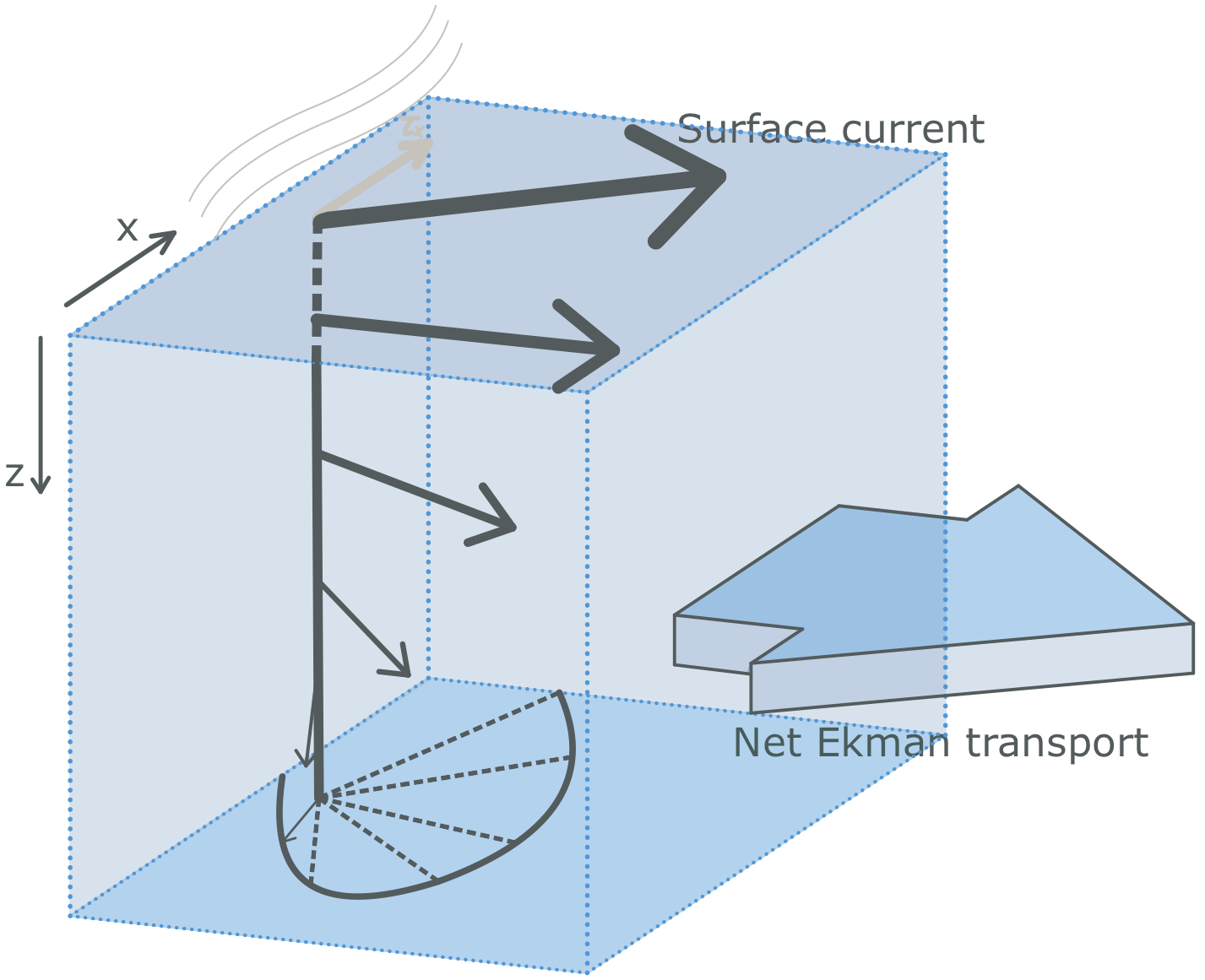These three processes, Ekman spiral, ocean gyres, and upwelling of water, are interconnected and play vital roles in shaping the dynamics of the Earth’s oceans and influencing marine ecosystems and weather patterns. Let us try to understand these three concepts separately…
Ekman Spiral

Ekman Spiral is a phenomenon that describes the motion of Ocean Currents under the influence of Winds and Earth’s rotation. This concept was named after the Swedish scientist Vagn Walfrid Ekman who first theorized it in 1902. Ekman Spiral is a result of combination of the Coriolis effect and friction.
Mechanism of Ekman Spiral
When the wind blows close to the surface, below 500 meters, it encounters frictional drag which causes it to slow down. This leads to a deflection of the wind, towards the right in the northern hemisphere and towards the left in the southern hemisphere. The extent of deflection decreases as the velocity of the wind decreases and the angle of deflection depends on the velocity of the wind. As a result of the deflection, the wind blows obliquely to the isobars. The angle of obliqueness increases with the increasing effect of frictional drag caused by the Earth’s surface, with an average value of 25°-35° for land surfaces and 10°-20° over the sea.
When the surface water molecules move due to the force of the wind, they drag deeper layers of water molecules below them. Each deeper layer moves more slowly than the layer above it, until the movement ceases at a depth of about 100 meters. The deeper water, like the surface water, is also deflected by the Coriolis effect, to the right in the Northern Hemisphere and to the left in the Southern Hemisphere. The mass transport of all the layers results in a 90° rotation.
Ocean Gyres

The Ekman Spiral also creates the large “mounds” of water in our oceans known as “gyres”. Ekman transport helps drive ocean gyres and contributes to their overall circulation patterns. By causing the flow towards the centre of the gyre, it imitates geostrophic flow. The Ekman Spiral is a fundamental concept in physical oceanography and helps us understand the ocean circulation patterns and the transport of heat, salt, and other properties in the ocean.

Ocean gyres are large rotating ocean currents that circulate clockwise in the Northern Hemisphere and counterclockwise in the Southern Hemisphere. They are driven by the Earth’s rotation, wind, and the distribution of ocean currents and water masses. Ocean gyres play a critical role in the ocean’s ability to distribute heat, salt, and other properties around the world.
There are five major ocean gyres
The North Atlantic, South Atlantic, North Pacific, South Pacific, and Indian Ocean gyres. These gyres move water in a circular pattern and can have a significant impact on ocean ecosystems, as they can trap and concentrate floating debris, such as plastic waste, into specific areas known as “garbage patches.”
Ocean gyres also have a significant impact on the Earth’s climate by transporting heat and carbon dioxide from the equator towards the poles. This helps regulate the Earth’s temperature and distribute heat and other properties around the world.

Upwelling of Water
Water upwelling and the Ekman Spiral are closely related phenomena in oceanography. Water upwelling is the movement of deep, nutrient-rich water towards the surface. This occurs when winds blow across the ocean surface, causing the water to move in the opposite direction, which in turn draws deeper water to the surface.

When the wind blows across the ocean surface, the surface water molecules move due to the wind’s force and drag deeper layers of water molecules with them. The deeper water is deflected by the Coriolis effect, leading to a 90° rotation of the mass transport of all the layers.
In areas of water upwelling, the wind stress at the surface causes the surface water to move away from the coast, drawing deeper water towards the surface. This deep water is then deflected by the Coriolis effect and moves in a spiral pattern, causing the upwelling of water.
This deep water is often rich in nutrients such as nitrates and phosphates, which support the growth of phytoplankton and other marine life.
There are two main types of upwelling: coastal upwelling and equatorial upwelling. Coastal upwelling occurs along the western coasts of continents and is caused by strong onshore winds that push surface water away from the coast. Equatorial upwelling, on the other hand, occurs in the equatorial region and is caused by winds blowing from east to west.
Upwelling is a critical process in the ocean, as it provides nutrients to the surface that support marine ecosystems and play a key role in the transfer of heat, carbon dioxide, and other properties in the ocean. It also helps regulate the Earth’s climate by removing carbon dioxide from the atmosphere and storing it in the ocean.
Water upwelling and the Ekman Spiral are intertwined processes in the ocean that are critical for the transfer of nutrients and other properties in the ocean and play a key role in supporting marine ecosystems.
